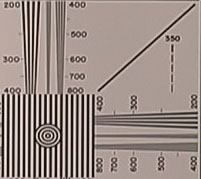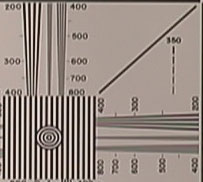
interlaced scan mode (full frame) |

"frame movie" mode (full frame) |

interlaced scan mode (full frame) |

"frame movie" mode (full frame) |
The Canon GL1 camera is 7 feet from the resolution test chart and adjusted so the pattern fills the full frame (click on an image to see full frame). The test chart measures 11.5 x 8.5 inches in size. (At maximum (optical) telephoto, the image would be 2x larger in each dimension.) Illumination is from a 500W halogen flood from the side, 4 feet away, at a steep angle. Measured from the camera's location, the spotmeter reading on the center (white) part of the chart is EV 13.6 and on the outer grey field, EV 12.3. The camera was on a tripod and set in auto white balance, image stabilization off, "sharpness" at default (center), auto focus, manual exposure, 1/60 sec, f/5.6, 0 dB gain. This is the same exposure setting as the camera chose in automatic mode. I tried manual focus but I couldn't do any better. Video was transferred over firewire directly into the computer while the camera was panned very slightly from side to side to obtain the best possible result as the vertical lines align with CCD pixels. The highest-apparent-resolution still frame was selected from each camera mode (interlaced and frame mode) and stored as a JPEG with no processing.
My observations based on these digital still results, as well as looking at the live s-video output on a TV:
A) This camera has about 500 lines of resolution by this test. In accord with expectation, it has slightly lower resolution than the Sony TRV900, as it has fewer pixels (GL1: 270k pixels, 250k effective. TRV900: 380k pixels). The GL1's "pixel shift" configuration may help, but it does not completely make up the difference.
B) Observe the horizontal lines in the two modes. You will note the vertical resolution in "frame movie" mode is slightly worse than in a full frame interlaced scan (this situation, fixed camera and still target, is the only situation in which you can simply combine two interlaced fields into a frame). The GL1 only captures 3/4 of a full frame and interpolates the remaining lines (according to a Canon representative). This lower-resolution image does not flicker when a still (freeze frame) is displayed on an interlaced TV or monitor. The TRV900 has a true progressive-scan CCD, and the picture does exhibit flicker during progressive-scan still playback on a TV, if the shot was sharply focused and contains fine detail.
C) You will note on the full 720x480 firewire frames, there are two black bars at left and right on the image: 7 pixels wide on the left and 6 pixels wide on the right, so the active image area is only 707x480 pixels. These bars are in the "overscan" region of any normal TV or monitor and thus not visible on video; however, this means stills obtained via firewire must be cropped to remove them.